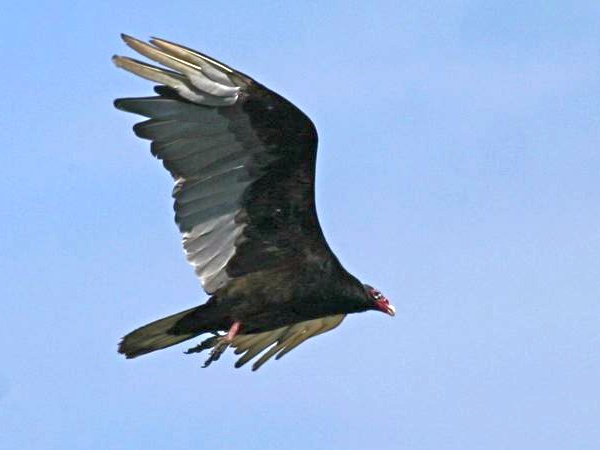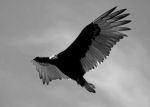
Lately several people have asked for help identifying huge dark birds. Based on the descriptions I think they’re seeing turkey vultures. Here are some pointers so you can solve the mystery on your own.
Turkey vultures are large dark birds of prey with a 5.5 foot wingspan. Because of their size they are confused with many hawks and even eagles. The best way to know the difference is to watch how they fly.
Hawks tend to soar with their wings held flat. Bald eagles have such a flat profile that they look as if they have “wings like planks.”
Turkey vultures soar with their wings in a dihedral — a shallow V. They rarely flap and even seem to avoid flapping by teetering from side to side. No other big bird consistently teeters with its wings in a V. “V is for Vulture.”
 From a distance, turkey vultures look different than other large birds because they have relatively small heads and beaks (compared to hawks and eagles) and their legs don’t extend beyond their bodies (compared to herons and cranes). As you can see in Chuck Tague’s pictures, these birds are dark below with a pale trailing edge on their wings and small red faces.
From a distance, turkey vultures look different than other large birds because they have relatively small heads and beaks (compared to hawks and eagles) and their legs don’t extend beyond their bodies (compared to herons and cranes). As you can see in Chuck Tague’s pictures, these birds are dark below with a pale trailing edge on their wings and small red faces.
Until a few years ago I only saw vultures in the country but now they’ve come to town. They nest along our rivers’ wooded hillsides and rise aloft on the heat from Downtown and the stadium parking lots.
In the afternoon they soar in search of carrion which they locate by their keen sense of smell. They’re so good at finding rotten odors that natural gas companies out West located leaks in their pipelines by watching where the turkey vultures congregated.
When you see large soaring birds teetering with their wings in a V, think “V is for Vulture.”
(photos by Chuck Tague)